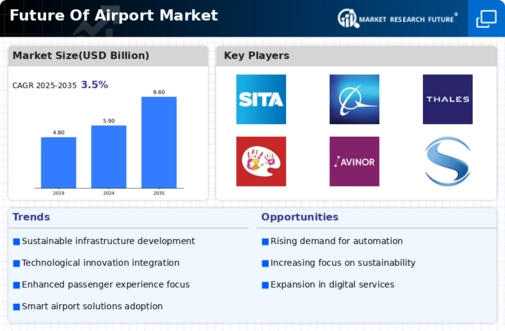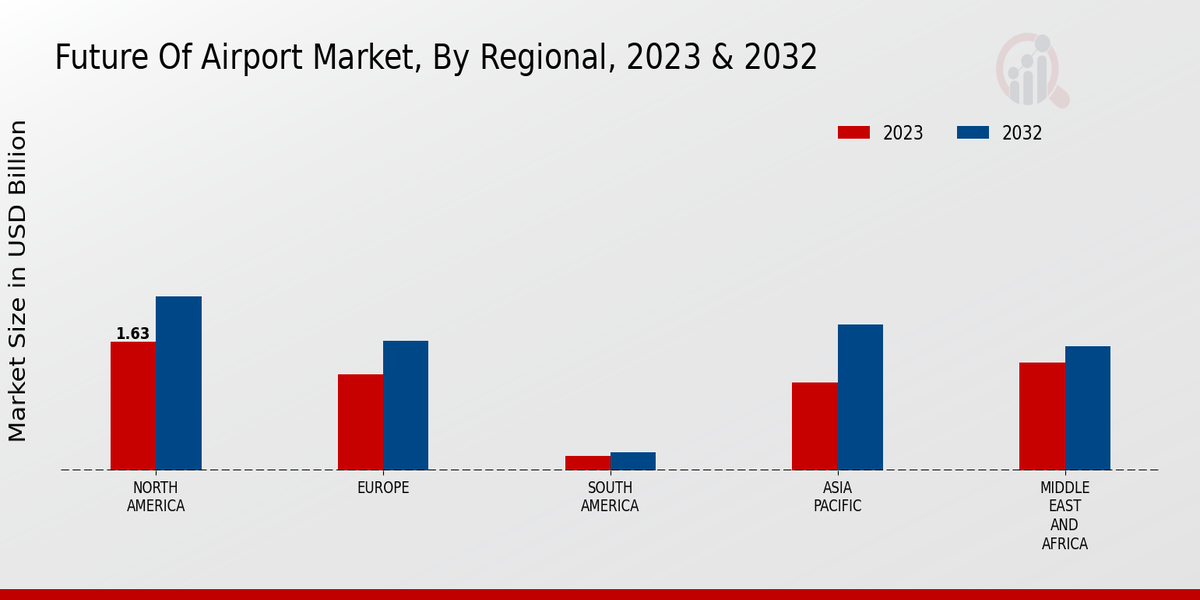Digital Transformation
Digital transformation is reshaping the Global Future Of Airport Market Industry, as airports adopt advanced digital solutions to enhance operational efficiency and customer experience. The integration of mobile applications, real-time data analytics, and cloud computing is enabling airports to streamline processes and improve service delivery. For example, many airports are implementing mobile check-in and boarding solutions, which can reduce congestion and enhance passenger satisfaction. This digital shift is likely to attract tech-savvy travelers and improve overall airport performance, thereby driving growth in the market as stakeholders embrace innovative solutions to meet evolving passenger expectations.
Government Investments
Government investments play a pivotal role in shaping the Global Future Of Airport Market Industry. Many countries are recognizing the strategic importance of airports as economic engines and are allocating substantial budgets for infrastructure development. For instance, various governments are funding projects aimed at expanding terminal capacities, improving runway systems, and enhancing passenger amenities. These investments not only facilitate smoother operations but also stimulate local economies by creating jobs and attracting tourism. The commitment of governments to bolster airport infrastructure is expected to significantly contribute to the market's growth trajectory in the coming years.
Market Growth Projections
The Global Future Of Airport Market Industry is projected to witness substantial growth, with estimates indicating a market value of 5.9 USD Billion in 2024 and an anticipated increase to 8.6 USD Billion by 2035. This growth trajectory reflects a compound annual growth rate of 3.49% from 2025 to 2035. The expansion is driven by various factors, including technological advancements, sustainability initiatives, and increased air travel demand. As airports continue to evolve and adapt to changing market dynamics, stakeholders are likely to invest in innovative solutions that enhance operational efficiency and passenger experience, further propelling market growth.
Sustainability Initiatives
Sustainability initiatives are becoming a cornerstone of the Global Future Of Airport Market Industry as airports strive to reduce their carbon footprint and enhance environmental stewardship. Many airports are investing in renewable energy sources, such as solar and wind, to power their operations. For example, several major airports have implemented green building standards and are transitioning to electric ground support equipment. These efforts not only align with global sustainability goals but also attract environmentally-conscious travelers. The emphasis on sustainable practices is likely to drive market growth, as stakeholders increasingly prioritize eco-friendly solutions in airport operations.
Technological Advancements
The Global Future Of Airport Market Industry is experiencing a transformative phase driven by rapid technological advancements. Innovations such as biometric screening, automated baggage handling, and artificial intelligence are enhancing operational efficiency and passenger experience. For instance, airports are increasingly adopting facial recognition systems to expedite security checks, which could potentially reduce wait times by up to 30 percent. This shift towards automation and smart technologies is expected to contribute to the market's growth, with projections indicating a market value of 5.9 USD Billion in 2024, and a further increase to 8.6 USD Billion by 2035, reflecting a compound annual growth rate of 3.49% from 2025 to 2035.
Increased Air Travel Demand
The Global Future Of Airport Market Industry is poised for growth due to the rising demand for air travel. As global economies recover and expand, the number of passengers is expected to increase significantly. According to projections, the number of air travelers could reach 8.2 billion by 2037, necessitating the expansion and modernization of airport infrastructure. This surge in demand compels airports to enhance their capacity and services, thereby driving investments in new technologies and facilities. The anticipated growth in passenger numbers is a key driver for the market, as airports seek to accommodate this influx while maintaining high service standards.











